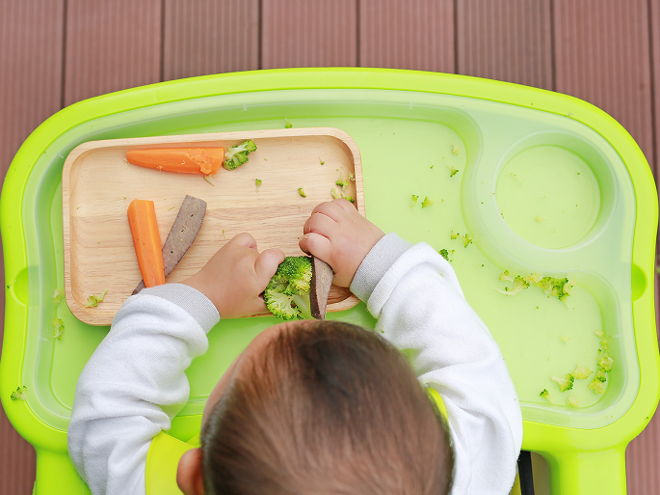
Veggie Encounters: Helping Babies Explore Greens at Their Own Pace
Building Comfort, Curiosity, and Routine Around Vegetables
Introducing vegetables can be a joyful part of your baby’s learning journey. Early mealtimes are about what’s on the plate and creating a safe, curious, and consistent experience.
This article explores how caregivers can gently support babies as they explore vegetables, one playful moment at a time.
Why Babies May Hesitate with New Foods
A. A World of New Sensations
Babies are still adjusting to the colors, textures, and smells of different foods. Vegetables might feel unfamiliar, and that’s normal. It’s natural for babies to pause, explore with their hands, or even push them away at first.
B. Curiosity Comes Before Comfort
For babies, exploring something new often comes before feeling fully comfortable. Remember that hesitation isn’t failure but apart of learning. With time, familiarity grows.
Creating a Positive Mealtime Routine
A. Start with Comfort and Familiarity
Establishing a simple routine helps babies feel secure. Use the same seat or mealtime cue (like a song or a wipe of the hands) to set expectations.
Even if they don’t touch the veggies today, just being at the table and observing matters.
B. Keep Pressure Low, Encouragement High
There’s no need to coax or push. Let your baby explore with their senses. A calm tone, a smile, and a “Look at that green bean!” go a long way in creating a relaxed space.
Making Vegetable Encounters Fun and Relaxed
A. Sensory Play at the Table
Try offering soft, steamed veggie sticks that baby can hold, poke, or squash.
Simple games like “Where’s the carrot?” add a layer of fun and curiosity.
B. Mix and Match Textures and Colors
Pair veggies with something familiar to make them feel less intimidating. Offer a small contrast—like bright orange and pale green—to make things visually interesting.
Involving the Whole Family
A. Leading by Example
Babies notice what you eat! When they see you enjoying vegetables, they learn that it’s a normal part of meals. Your calm presence and genuine interest also make a difference.
B. Making It a Shared Moment
Add simple rituals to family meals—name the veggie, sing a song, or describe the color. Even without eating, your baby is learning from the shared experience.
Gentle Games and Engagement Ideas
A. “Veggie of the Day” Exploration
Pick one veggie to spotlight, and make sure there’s no pressure to eat. Let your baby hold it, tap it, or explore it visually. A playful tone like “Here comes the zucchini!” keeps it light and fun.
B. Storytime, Songs, and Smiles
Bring in books or sing veggie-themed songs before or during mealtime. Associating vegetables with joy helps build familiarity over time.
Encouragement Without Expectation
A. Celebrate Curiosity
Touching, pointing, or even making a funny face? That’s worth clapping for. Your response reinforces exploration as something safe and fun.
B. Trust the Process
It takes time. Repeated, pressure-free exposure helps vegetables become familiar. Focus less on what’s eaten and more on the shared, calm experience.
Final Thoughts
Introducing vegetables doesn’t need to be a challenge—it can be a shared adventure! With consistency, calm, and curiosity, babies learn at their own pace. And celebrate each small moment of interest, and trust that comfort and confidence will come with time.









